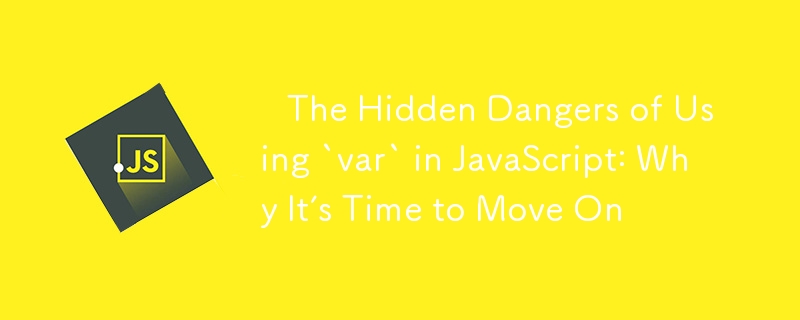⚠️ 在 JavaScript 中使用 `var` 的隱藏危險:為什麼是時候繼續前進了

關鍵字 var 多年來一直是 JavaScript 中宣告變數的預設方式。但是,它有一些怪癖和陷阱,可能會導致程式碼出現意外行為。現代替代方案(如 let 和 const)解決了許多此類問題,使它們成為大多數情況下聲明變數的首選。
1️⃣ 提升:var 在你知道之前就聲明了變數!
?說明:
在 JavaScript 中,var 宣告會提升到其作用域的頂部,這意味著即使宣告稍後出現在程式碼中,它們也會被初始化為未定義。這可能會導致令人困惑的行為並導致難以檢測的錯誤。
?重點:
- ? 提升操作:變數宣告被移到作用域的頂部,但它們的賦值卻沒有。
- ? 意外的未定義值: 變數可以在賦值之前使用,導致意外的未定義結果。
?例:
console.log(myVar); // undefined (hoisted but not initialized) var myVar = 10; console.log(myVar); // 10
?註: 變數 myVar 被提升到作用域的頂部,但最初是未定義的,這可能會導致程式碼混亂。
?修復:
- ? 使用let或const:這些關鍵字的提升方式與var不同,這有助於防止此問題。
?修復範例:
console.log(myLet); // ReferenceError: myLet is not defined let myLet = 10; console.log(myLet); // 10
?評論: 使用 let 可以防止變數在聲明之前被訪問,從而減少混亂和潛在的錯誤。
2️⃣ 函數作用域與區塊作用域:var 可能會洩漏到區塊之外!
?說明:
var 的主要缺陷之一是它是函數作用域,而不是區塊作用域。這意味著在循環、if 語句或其他區塊內聲明的變數不限於該區塊,而是可以在其外部訪問,這可能會導致錯誤。
?重點:
- ? 函數作用域: var 的作用域為最近的函數,即使在循環或 if 語句等區塊內聲明也是如此。
- ? 洩漏變數:這可能會導致變數無意中洩漏出區塊,從而導致不可預測的行為。
?例:
if (true) {
var blockVar = "I’m accessible outside this block";
}
console.log(blockVar); // "I’m accessible outside this block"
?註: 雖然 blockVar 是在 if 區塊內聲明的,但它仍然可以在區塊外訪問,因為 var 是函數作用域,而不是區塊作用域。
?修復:
- ? 使用let或const:這些關鍵字是區塊作用域的,這意味著它們只能在定義它們的區塊內存取。
?修復範例:
if (true) {
let blockLet = "I’m only accessible inside this block";
}
console.log(blockLet); // ReferenceError: blockLet is not defined
?註: 使用 let 或 const 可確保變數保持在各自的區塊內,防止作用域洩漏。
3️⃣ 重新宣告問題:var 讓您可以兩次宣告相同的變數!
?說明:
使用 var,您可能會意外地在同一作用域中重新宣告相同變量,這可能會覆寫先前的值。這可能會導致無意的錯誤,尤其是在較大的程式碼庫中,變數名稱可能會被錯誤地重複使用。
?重點:
- ? 重新宣告變數: var 允許您在相同範圍內重新宣告變數,可能會覆寫現有值。
- ? 意外覆蓋:這可能會導致難以檢測的錯誤,尤其是在大型或複雜的函數中。
?例:
var name = "Alice"; var name = "Bob"; // No error, overwrites the previous value console.log(name); // "Bob"
?評論: 第二個名稱聲明會覆寫第一個名稱,可能會導致程式碼中出現錯誤。
?修復:
- ? 使用let或const:這些關鍵字可以防止您在同一範圍內重新聲明變量,從而降低意外覆蓋的風險。
?修復範例:
let name = "Alice"; let name = "Bob"; // SyntaxError: Identifier 'name' has already been declared
?評論: 使用 let 或 const 可以幫助您避免重新聲明變數並確保您的程式碼保持可預測性。
循環中的 4️⃣ var:非同步程式碼中潛在的錯誤
?說明:
在循環中使用 var 時,變數的值可能會以意想不到的方式更改,尤其是在使用非同步程式碼時。由於 var 是函數作用域而不是區塊作用域,因此在非同步回呼內存取時,循環變數可能會包含意外值。
?重點:
- ? Loop Variables: Variables declared with var inside loops are not confined to the loop block, leading to potential bugs when accessed later.
- ⏳ Asynchronous Issues: This can cause bugs in asynchronous operations like setTimeout or promises, where the loop variable might have an unexpected value.
? Example:
for (var i = 0; i < 3; i++) {
setTimeout(() => console.log(i), 1000); // Prints: 3, 3, 3 (unexpected)
}
? Comment: Because var is not block-scoped, the loop variable i is shared across all iterations, and its final value (3) is used in each setTimeout callback.
? Fix:
- ⛓ Use let: The let keyword is block-scoped, ensuring that each iteration of the loop gets its own independent value of the loop variable.
? Example Fix:
for (let i = 0; i < 3; i++) {
setTimeout(() => console.log(i), 1000); // Prints: 0, 1, 2 (as expected)
}
? Comment: Using let creates a new instance of i for each iteration, fixing the asynchronous callback issue and ensuring the correct values are printed.
5️⃣ var and Closures: A Source of Confusion
? Explanation:
Closures can lead to unexpected behavior when combined with var. Since var is function-scoped, its value might change in ways that are not expected when a closure captures it.
? Key Points:
- ? Closures in JavaScript: A closure is a function that remembers its surrounding scope even after the outer function has finished executing.
- ? Shared Variable Issues: When var is used inside a closure, the captured variable might be shared across all closures, leading to unexpected behavior.
? Example:
function createFunctions() {
var funcs = [];
for (var i = 0; i < 3; i++) {
funcs.push(function() {
console.log(i);
});
}
return funcs;
}
var myFuncs = createFunctions();
myFuncs[0](); // 3 (unexpected)
myFuncs[1](); // 3 (unexpected)
myFuncs[2](); // 3 (unexpected)
? Comment: All closures are capturing the same i value because var is function-scoped, leading to unexpected results.
? Fix:
- ? Use let: By using let, each closure captures a new instance of the loop variable, solving the problem.
? Example Fix:
function createFunctions() {
var funcs = [];
for (let i = 0; i < 3; i++) {
funcs.push(function() {
console.log(i);
});
}
return funcs;
}
var myFuncs = createFunctions();
myFuncs[0](); // 0
myFuncs[1](); // 1
myFuncs[2](); // 2
? Comment: With let, each closure gets its own copy of i, fixing the issue and ensuring the expected values are printed.
? Conclusion: Time to Say Goodbye to var
While var was the original way to declare variables in JavaScript, it has several shortcomings that make it a poor choice in modern JavaScript development. The introduction of let and const provides better scoping, reduces the risk of bugs, and makes your code more predictable. To write cleaner and more maintainable JavaScript, it's time to move on from var and embrace let and const.
以上是⚠️ 在 JavaScript 中使用 `var` 的隱藏危險:為什麼是時候繼續前進了的詳細內容。更多資訊請關注PHP中文網其他相關文章!

熱AI工具

Undress AI Tool
免費脫衣圖片

Undresser.AI Undress
人工智慧驅動的應用程序,用於創建逼真的裸體照片

AI Clothes Remover
用於從照片中去除衣服的線上人工智慧工具。

Clothoff.io
AI脫衣器

Video Face Swap
使用我們完全免費的人工智慧換臉工具,輕鬆在任何影片中換臉!

熱門文章

熱工具

記事本++7.3.1
好用且免費的程式碼編輯器

SublimeText3漢化版
中文版,非常好用

禪工作室 13.0.1
強大的PHP整合開發環境

Dreamweaver CS6
視覺化網頁開發工具

SublimeText3 Mac版
神級程式碼編輯軟體(SublimeText3)
 如何在JS中與日期和時間合作?
Jul 01, 2025 am 01:27 AM
如何在JS中與日期和時間合作?
Jul 01, 2025 am 01:27 AM
JavaScript中的日期和時間處理需注意以下幾點:1.創建Date對像有多種方式,推薦使用ISO格式字符串以保證兼容性;2.獲取和設置時間信息可用get和set方法,注意月份從0開始;3.手動格式化日期需拼接字符串,也可使用第三方庫;4.處理時區問題建議使用支持時區的庫,如Luxon。掌握這些要點能有效避免常見錯誤。
 為什麼要將標籤放在的底部?
Jul 02, 2025 am 01:22 AM
為什麼要將標籤放在的底部?
Jul 02, 2025 am 01:22 AM
PlacingtagsatthebottomofablogpostorwebpageservespracticalpurposesforSEO,userexperience,anddesign.1.IthelpswithSEObyallowingsearchenginestoaccesskeyword-relevanttagswithoutclutteringthemaincontent.2.Itimprovesuserexperiencebykeepingthefocusonthearticl
 什麼是在DOM中冒泡和捕獲的事件?
Jul 02, 2025 am 01:19 AM
什麼是在DOM中冒泡和捕獲的事件?
Jul 02, 2025 am 01:19 AM
事件捕獲和冒泡是DOM中事件傳播的兩個階段,捕獲是從頂層向下到目標元素,冒泡是從目標元素向上傳播到頂層。 1.事件捕獲通過addEventListener的useCapture參數設為true實現;2.事件冒泡是默認行為,useCapture設為false或省略;3.可使用event.stopPropagation()阻止事件傳播;4.冒泡支持事件委託,提高動態內容處理效率;5.捕獲可用於提前攔截事件,如日誌記錄或錯誤處理。了解這兩個階段有助於精確控制JavaScript響應用戶操作的時機和方式。
 如何減少JavaScript應用程序的有效載荷大小?
Jun 26, 2025 am 12:54 AM
如何減少JavaScript應用程序的有效載荷大小?
Jun 26, 2025 am 12:54 AM
如果JavaScript應用加載慢、性能差,問題往往出在payload太大,解決方法包括:1.使用代碼拆分(CodeSplitting),通過React.lazy()或構建工具將大bundle拆分為多個小文件,按需加載以減少首次下載量;2.移除未使用的代碼(TreeShaking),利用ES6模塊機制清除“死代碼”,確保引入的庫支持該特性;3.壓縮和合併資源文件,啟用Gzip/Brotli和Terser壓縮JS,合理合併文件並優化靜態資源;4.替換重型依賴,選用輕量級庫如day.js、fetch
 JavaScript模塊上的確定JS綜述:ES模塊與COMPORJS
Jul 02, 2025 am 01:28 AM
JavaScript模塊上的確定JS綜述:ES模塊與COMPORJS
Jul 02, 2025 am 01:28 AM
ES模塊和CommonJS的主要區別在於加載方式和使用場景。 1.CommonJS是同步加載,適用於Node.js服務器端環境;2.ES模塊是異步加載,適用於瀏覽器等網絡環境;3.語法上,ES模塊使用import/export,且必須位於頂層作用域,而CommonJS使用require/module.exports,可在運行時動態調用;4.CommonJS廣泛用於舊版Node.js及依賴它的庫如Express,ES模塊則適用於現代前端框架和Node.jsv14 ;5.雖然可混合使用,但容易引發問題
 如何在node.js中提出HTTP請求?
Jul 13, 2025 am 02:18 AM
如何在node.js中提出HTTP請求?
Jul 13, 2025 am 02:18 AM
在Node.js中發起HTTP請求有三種常用方式:使用內置模塊、axios和node-fetch。 1.使用內置的http/https模塊無需依賴,適合基礎場景,但需手動處理數據拼接和錯誤監聽,例如用https.get()獲取數據或通過.write()發送POST請求;2.axios是基於Promise的第三方庫,語法簡潔且功能強大,支持async/await、自動JSON轉換、攔截器等,推薦用於簡化異步請求操作;3.node-fetch提供類似瀏覽器fetch的風格,基於Promise且語法簡單
 編寫清潔和可維護的JavaScript代碼的最佳實踐是什麼?
Jun 23, 2025 am 12:35 AM
編寫清潔和可維護的JavaScript代碼的最佳實踐是什麼?
Jun 23, 2025 am 12:35 AM
要寫出乾淨、可維護的JavaScript代碼,應遵循以下四點:1.使用清晰一致的命名規範,變量名用名詞如count,函數名用動詞開頭如fetchData(),類名用PascalCase如UserProfile;2.避免過長函數和副作用,每個函數只做一件事,如將更新用戶信息拆分為formatUser、saveUser和renderUser;3.合理使用模塊化和組件化,如在React中將頁面拆分為UserProfile、UserStats等小組件;4.寫註釋和文檔時點到為止,重點說明關鍵邏輯、算法選
 垃圾收集如何在JavaScript中起作用?
Jul 04, 2025 am 12:42 AM
垃圾收集如何在JavaScript中起作用?
Jul 04, 2025 am 12:42 AM
JavaScript的垃圾回收機制通過標記-清除算法自動管理內存,以減少內存洩漏風險。引擎從根對像出發遍歷並標記活躍對象,未被標記的則被視為垃圾並被清除。例如,當對像不再被引用(如將變量設為null),它將在下一輪迴收中被釋放。常見的內存洩漏原因包括:①未清除的定時器或事件監聽器;②閉包中對外部變量的引用;③全局變量持續持有大量數據。 V8引擎通過分代回收、增量標記、並行/並發回收等策略優化回收效率,降低主線程阻塞時間。開發時應避免不必要的全局引用、及時解除對象關聯,以提升性能與穩定性。







